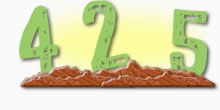The following entries were made in the “Access Counts” category.
Archive for “Access Counts”
Web Site Navigation Menu Placement
 I was asked in an email recently what my feelings were regarding the placement of a navigation menu on a web site. The person asking wanted to know the latest scoop on the advantages or disadvantages of various menu placements. Is a right-hand vertical menu better somehow than a left-hand vertical menu? How about a horizontal navigation menu at the top of the page? Over the years I’ve made them all at one time or another, though lately most have been vertical right-hand menus. I responded with all I knew about the subject, then admitted the info may be dated. Here’s basically what I offered:
I was asked in an email recently what my feelings were regarding the placement of a navigation menu on a web site. The person asking wanted to know the latest scoop on the advantages or disadvantages of various menu placements. Is a right-hand vertical menu better somehow than a left-hand vertical menu? How about a horizontal navigation menu at the top of the page? Over the years I’ve made them all at one time or another, though lately most have been vertical right-hand menus. I responded with all I knew about the subject, then admitted the info may be dated. Here’s basically what I offered:
Continue reading “Web Site Navigation Menu Placement” »
Understanding Web Accessibility Obstacles
 More than any other factor, it is the understanding of web accessibility obstacles that has best assisted me in the pursuit of making my sites and those of my clients as accessible as possible. But isn’t that always the way? We cannot avoid danger if we cannot recognize it. That’s what I tell my son. I stress that he can do anything he wants to in life, but before jumping in with both feet he would be smart to first identify the risks so that he may avoid them. As this pertains to web accessibility the risks are, of course, a lack of access to those who need it. And to succeed, we are smart to first identify those risks so that we, too, may avoid them. On behalf of our sites’ users.
More than any other factor, it is the understanding of web accessibility obstacles that has best assisted me in the pursuit of making my sites and those of my clients as accessible as possible. But isn’t that always the way? We cannot avoid danger if we cannot recognize it. That’s what I tell my son. I stress that he can do anything he wants to in life, but before jumping in with both feet he would be smart to first identify the risks so that he may avoid them. As this pertains to web accessibility the risks are, of course, a lack of access to those who need it. And to succeed, we are smart to first identify those risks so that we, too, may avoid them. On behalf of our sites’ users.
Continue reading “Understanding Web Accessibility Obstacles” »
Adding a Map to Your Web Site
 Local brick-n-mortar businesses, those who rely on walk-in, on-location commerce, will often have a web site to promote their business. It’s a good idea. The cost of having a web site is next to nothing, maintenance is easy if the site was built with updating in mind, and it can be a great service to existing and potential customers, depending on how it’s used. One such service would be helping the potential client find the business’s physical location. This can be easily facilitated by adding a location map to the site. How one should do this is the subject of this article.
Local brick-n-mortar businesses, those who rely on walk-in, on-location commerce, will often have a web site to promote their business. It’s a good idea. The cost of having a web site is next to nothing, maintenance is easy if the site was built with updating in mind, and it can be a great service to existing and potential customers, depending on how it’s used. One such service would be helping the potential client find the business’s physical location. This can be easily facilitated by adding a location map to the site. How one should do this is the subject of this article.
Continue reading “Adding a Map to Your Web Site” »
My WCAG 2.0 AAA Implementation
 A while back I mentioned I made a AAA web site that conformed to the Web Content Accessibility Guidelines (WCAG) version 2.0. The site was for California disability rights attorney, Lainey Feingold, who works primarily with the blind and visually impaired community on technology and information access issues. She is nationally recognized for negotiating accessibility agreements and for pioneering the collaborative advocacy and dispute resolution method known as Structured Negotiations. That’s from her site — a site which is one of just two AAA implementations (the other being Vision Australia).
A while back I mentioned I made a AAA web site that conformed to the Web Content Accessibility Guidelines (WCAG) version 2.0. The site was for California disability rights attorney, Lainey Feingold, who works primarily with the blind and visually impaired community on technology and information access issues. She is nationally recognized for negotiating accessibility agreements and for pioneering the collaborative advocacy and dispute resolution method known as Structured Negotiations. That’s from her site — a site which is one of just two AAA implementations (the other being Vision Australia).
Continue reading “My WCAG 2.0 AAA Implementation” »
Should Web Developers Support 800×600?
 That question is hot on the mailing list run by the Guild of Accessible Web Designers (GAWDS) right now. Specifically Accessites has been called on to explain why it is has one submission criterion demanding support for an 800×600 monitor resolution — meaning that it must be viewable without side-scrolling. Apparently more than a handful of developers at GAWDS feel that 800×600 support is a bit out-dated and no longer needed as it once was. I’ll answer this, not for Accessites, but rather for myself. I’ll explain why I feel it’s important to support that smaller resolution — or maybe I should say window size, since not everyone computes or browses with their windows maximized.
That question is hot on the mailing list run by the Guild of Accessible Web Designers (GAWDS) right now. Specifically Accessites has been called on to explain why it is has one submission criterion demanding support for an 800×600 monitor resolution — meaning that it must be viewable without side-scrolling. Apparently more than a handful of developers at GAWDS feel that 800×600 support is a bit out-dated and no longer needed as it once was. I’ll answer this, not for Accessites, but rather for myself. I’ll explain why I feel it’s important to support that smaller resolution — or maybe I should say window size, since not everyone computes or browses with their windows maximized.
Continue reading “Should Web Developers Support 800×600?” »
Keyboard Support: Mysteries Unveiled
 As you may or may not know, dear reader, I’ve divided my time between my usual role as a web developer and my newer passion for photography. If not, I’ve recently explained it. Being so divided and all, I’ve somewhat neglected reading other people’s blogs, now only spending a fraction of the time doing so. I’m still out there, though. Just recently, in fact, I was checking out that A List Apart (ALA) article by Dave Shea: CSS Sprites2 - It’s JavaScript Time.
As you may or may not know, dear reader, I’ve divided my time between my usual role as a web developer and my newer passion for photography. If not, I’ve recently explained it. Being so divided and all, I’ve somewhat neglected reading other people’s blogs, now only spending a fraction of the time doing so. I’m still out there, though. Just recently, in fact, I was checking out that A List Apart (ALA) article by Dave Shea: CSS Sprites2 - It’s JavaScript Time.
Continue reading “Keyboard Support: Mysteries Unveiled” »
Web Excessibility
 They say too much of a good thing isn’t all that good. It’s true, and this fact remains as the statement is applied to web development. Especially when it’s applied to the web accessibility branch. Let’s explore this. Web accessibility is a good thing, right? You bet it is, from its benefits to myriad users to its benefits to the site in the area of search engine indexing. It’s win-win all the way. But before jumping in and going wild with its application and adherence on your next project, making sure your site is accessible to the nth degree and all that, it can be overdone.
They say too much of a good thing isn’t all that good. It’s true, and this fact remains as the statement is applied to web development. Especially when it’s applied to the web accessibility branch. Let’s explore this. Web accessibility is a good thing, right? You bet it is, from its benefits to myriad users to its benefits to the site in the area of search engine indexing. It’s win-win all the way. But before jumping in and going wild with its application and adherence on your next project, making sure your site is accessible to the nth degree and all that, it can be overdone.
Continue reading “Web Excessibility” »
Web Semantics and Search
 Semantics, schemantics, right? If that’s your view, you might want to start questioning it now. The importance of web semantics may be on the rise. Semantics is meaning. On the web semantic HTML conveys this meaning to the user and his or her user agent. It lends itself to web accessibility, and the clear content organization is extraordinarily helpful to being properly indexed by search engines. Someday this fact may be more important than ever thanks to an interesting new approach to search.
Semantics, schemantics, right? If that’s your view, you might want to start questioning it now. The importance of web semantics may be on the rise. Semantics is meaning. On the web semantic HTML conveys this meaning to the user and his or her user agent. It lends itself to web accessibility, and the clear content organization is extraordinarily helpful to being properly indexed by search engines. Someday this fact may be more important than ever thanks to an interesting new approach to search.
Continue reading “Web Semantics and Search” »
Will the Road to HTML 5 be Rough?
 I am really impressed with the HTML 5 work being performed by Ian Hickson, as the draft editor, and the others who are part of the WHATWG. I’m a fan of the work, and I believe it has promise. From the updated meaning of some of those gray area elements, to the deprecation (made obsolete) of some of the garbage that has littered the web for the past fifteen years, to the introduction of new elements that will offer organizational value where none exists today, to the introduction of new attributes to give all elements clearer meaning, it all bodes well with me. But I cannot help but wonder how we will get there.
I am really impressed with the HTML 5 work being performed by Ian Hickson, as the draft editor, and the others who are part of the WHATWG. I’m a fan of the work, and I believe it has promise. From the updated meaning of some of those gray area elements, to the deprecation (made obsolete) of some of the garbage that has littered the web for the past fifteen years, to the introduction of new elements that will offer organizational value where none exists today, to the introduction of new attributes to give all elements clearer meaning, it all bodes well with me. But I cannot help but wonder how we will get there.
Continue reading “Will the Road to HTML 5 be Rough?” »

